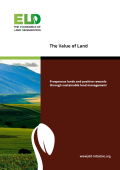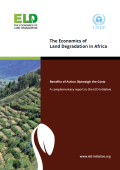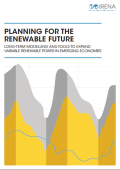
With around one-third of the world’s arable land degraded, estimated annual losses of 6.3 to 10.6 USD trillion, and a projected need to increase food production from land by 70 percent by 2050, we simply cannot afford to neglect the loss of potential production from careless land management. Whenever land is not producing at its potential, it is an underperforming asset that requires investments to ensure the future supply chains that many industries depend upon.

This report provides evidence of how increasingly scarce resources can be conserved and also presents tools for policy-/decision-makers to promote and secure future wealth and human well-being through sustainable land management. It emphasises taking long-term benefits into account and focuses on practical solutions, as well as the context in which sustainable land management occurs. The report aims to ensure the returns of sustainable land management (e.g., economic growth, food security, sustainable livelihoods and reduced conflict over natural resources) are realised through the use of robust economic valuation methodologies. The report also highlights that sustainable land management provides additional benefits at the national level through obligations under other multilateral environmental agreements, such as the UN Convention to Combat Desertification (UNCCD), e.g., through achieving land degradation neutrality, the UNFCCC, and the Convention on Biological Diversity (CBD).


Land degradation and desertification are among of the world’s greatest environmental challenges. It is estimated that desertification affects about 33 % of the global land surface, and that over the past 40 years erosion has removed nearly one-third of the world’s arable land from production. Africa is particularly vulnerable to land degradation and desertification, and it is the most severely affected region. Desertification affects around 45 % of Africa’s land area, with 55 % of this area at high or very high risk of further degradation.

Ambitious national commitments, international agreements, and rapid technological progress have prompted countries around the world to turn increasingly renewable energy to expand their power infrastructure. However, the variability of solar and wind energy – two key sources for renewable power generation – presents new challenges.
Proactive energy planners will address the challenges of variable renewable energy (VRE) integration directly, starting with long-term investment choices. Techno-economic assessments can help to inform policy development and set optimal targets for renewable power uptake. Scenario modelling, meanwhile, has become a critical planning tool for the power sector, with considerable knowledge being acquired in certain markets on how to represent VRE in long-term models.
This report highlights the findings from AVRIL (“Addressing Variable Renewable Energy in Long-term Energy Planning”), a project by the International Renewable Energy Agency (IRENA) that has identified the best practices in long-term planning and modelling to represent high shares of VRE.
